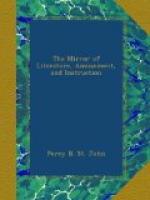The benefits which the inhabitants of frigid regions derive from seals, are far too numerous and diversified to be particularized, as they supply them with almost all the conveniences of life. We, on the contrary, so persecute this animal, as to destroy hundreds of thousands annually, for the sake of the pure and transparent oil with which the seal abounds; 2ndly, for its tanned skin, which is appropriated to various purposes by different modes of preparation; and thirdly, we pursue it for its close and dense attire. In the common seal, the hair of the adult is of one uniform kind, so thickly arranged and imbued with oil, as to effectually resist the action of water; while, on the contrary, in the antarctic seals the hair is of two kinds: the longest, like that of the northern seals; the other, a delicate, soft fur, growing between the roots of the former, close to the surface of the skin, and not seen externally; and this beautiful fur constitutes an article of very increasing importance in commerce; but not only does the clothing of the seal vary materially in colour, fineness, and commercial situation, in the different species, but not less so in the age of the animal. The young of most kinds are usually of a very light colour, or entirely white, and are altogether destitute of true hair, having this substituted by a long and particularly soft fur.—Quarterly Journal.
Method of cutting Glass.
If a tube, or goblet, or other round glass body is to be cut, a line is to be marked with a gun flint having a sharp angle, an agate, a diamond, or a file, exactly on the place where it is to be cut. A long thread covered with sulphur is then to be passed two or three times round the circular line, and to be inflamed and burnt; when the glass is well heated some drops of cold water are to be thrown on it, when the piece will separate in an exact manner, as if cut with scissors. It is by this means that glasses are cut circularly into thin bands, which may either be separated from, or repose upon each other, at pleasure, in the manner of a spring—–From the French.
Preservation of Skins.
A tanner at Tyman, in Hungary, uses with great advantage the pyroligueous acid, in preserving skins from putrefaction, and in recovering them when attacked. They are deprived of none of their useful qualities if covered by means of a brush with the acid, which they absorb very readily.—Quarterly Journal.
Organic Remains in Sussex.
A short time since, the entire skeleton of a stag, of very large size, was dug up by some labourers, in excavating the bed of the river Ouse, near Lewes, in Sussex. The remains were found imbedded in a layer of sand, beneath the alluvial blue clay, forming the surface of the valley. The horns were in the highest state of preservation, and had seven points, like the American deer. The greater part of the skeleton was destroyed by the carelessness of the workmen; but a portion, including the horns, has been preserved in the collection of Mr. Mantell, near Lewes.




